
528 Chama, N.E., Albuquerque, NM 87108 http://www.cbass.com |

Mr. America Past 40, Short Class
Clarence Bass by Russ Warner
+
|
|
|
Fitness Success Stories
(19)
We've heard many success stories over the years, and
here are some of them that are
especially noteworthy and inspiring.
Fit Senior Weighs Blood Pressure Medication
For the seasoned strength and fitness trainer, the meaning of "success" changes with the years. Size and strength will increasingly be defined by the qualifier "for my age," and "health" likely will include health-sustaining medications.
As a strong 88-year-old lifter (225 pound trap-bar deadllfts for 25 reps) in overall good health, I have had to confront complex issues concerning medication.
I'm not anti-medication, but I am aware of the impact pharmaceutical companies have in selling their products and increasing their profits, and the role physicians play in employing--or "over employing"--these medicines. In the U.S. the average ambulatory "senior" takes six or more prescription medications, a practice that has come to be labeled "polypharmacy," which led a PBS story to ask whether overmedicating seniors has become America’s other drug problem.
Again, I want to underscore that I'm not anti-medication. Four years ago, I had a bike accident that left me unconscious and without any memory of how the accident occurred. On the way to the hospital and during my hospital stay, I had irregular heartbeats, which the physicians speculated could have contributed to my losing consciousness and creating the accident. I've always believed the irregular heartbeats were a consequence of the trauma I experienced, but being cautious, I've continued taking a medication to normalize heart rhythms.
Has the medication contributed to my continued well-being? I'm not sure. I powerwalk up steep inclines a few times a week and have never once had a recurrence of the problem. Nonetheless, I am comfortable erring on the safe side for my continued health.
I dutifully take the medication every day.
On the other hand, I've drawn a different conclusion about medication for blood pressure. I don't know if I actually have high blood pressure because I have a severe case of "white coat syndrome." Whether I'm in a doctor's office or at home, the mere thought of measuring my blood pressure is certain to amplify my anxiety and raise my blood pressure numbers. Consequently, to help determine if I should take blood pressure medication for my health, I've examined the research literature and drawn the following conclusions.
First, there is the association between high blood pressure and mortality. For an older lifter like myself, one research finding was especially eye-opening. A study of over 600 participants 80 years and older found "no association between blood pressure levels and mortality."
Second, this research provides even better news for adults 85 and older: Not only did the researchers find NO MEANINGFUL relation between blood pressure and all cause mortality, healthier oldsters lived longer--regardless of their blood pressure levels.
In other words, overall health is a very significant factor in assessing the potential health impact of blood pressure levels.
Third, looking at blood pressure another way, for older adults how meaningful and beneficial for continued health are normal blood pressure numbers? Stunningly, another study found that adults 80 years old and over who had blood pressure 140/90 or under (within the normal range) "actually had a 40 percent higher mortality risk than peers with blood pressure readings exceeding those thresholds."
Even people who have already had a stroke or a heart attack presented a similar link between blood pressure and mortality risk. For this latter group, those who had "blood pressure lower than 140/90 mm Hg had a 61 percent higher risk of death than those whose blood pressure remained high in spite of their anti-hypertensive drug regimen."
Fourth, another research finding underscores the benefit of my 70 years of lifting: older men in the upper third of muscular strength and fitness had the lowest mortality risk. Even more tellingly for my own continued power level, the researchers found that high levels of muscular strength and overall fitness "appear to protect hypertensive men against all-cause mortality, and this is in addition to the benefit provided by cardio-respiratory fitness."
In other words, my continued combination of lifting and power walking make a very beneficial duo for health maintenance.
Finally, the older lifter also needs to consider side effects. With respect to blood pressure medications, a common serious and frequently deadly side effect is falling.
One study assessing this side effect found that older adults on blood pressure medication increased their "risk of serious fall injuries by 30% to 40% —an effect similar to strokes and heart attacks."
* * *
Have I made the right decision in declining blood pressure medications? I believe I have.
Be that as it may, the chief point of my “success story” is that health becomes an increasingly significant area of “success,” one requiring the trainer to learn about and participate in decision-making regarding health.
While some medical decisions are clear cut, others would benefit from the knowledge acquired from a lifetime devoted to staying strong, fit and healthy.
Be informed.
Gerald Coles
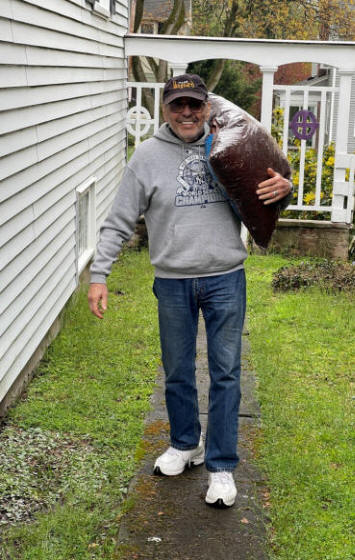
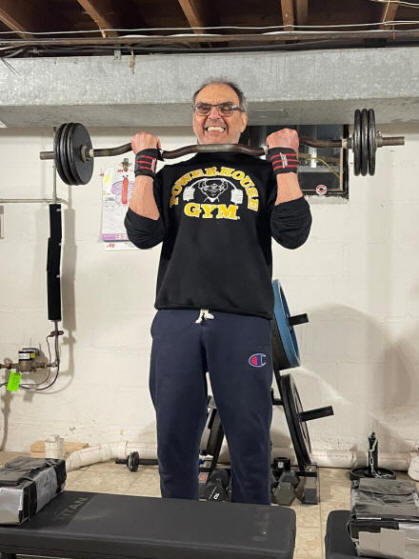
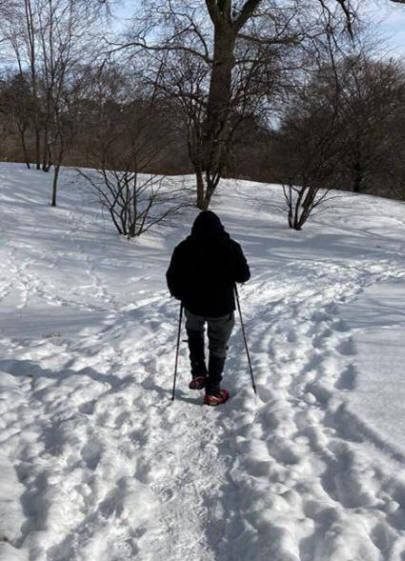
Gerald reminds us that strength comes in different forms. That pushing or pulling in the gym can always be adjusted for success, by adding or reducing weight.
While carrying 40 pound bags of mulch from your car into your yard or trekking in the snow require different forms of effort.
You have to step up to the task, which doesn't moderate.
Gerald thrives on tackling all three forms of stress, knowing that the day may come when he's not able to be so active. His time in the gym pushes that day into the future.
May 1, 2023
The Budge Collins Story
Lifestyle Overcomes Alzheimer's Gene
Recently I was speaking with Clarence about what I’ve done to prevent or delay Alzheimer's disease. He suggested that I write a short summary of my success for his website.
I have one Alzheimer's gene. Any of us could have inherited one or two of these genes from our parents. Having one gene presents a 30% higher probability of getting Alzheimer's disease. If two genes are present, we have a 60-90% higher probability of getting Alzheimer's disease.
As an aside, anyone can learn whether they have the gene by a simple, inexpensive blood test done when you have your normal labs drawn.
A few years ago I read the The Alzheimer’s Solution by Drs. Dean and Ayesha Sherzai, both neurologists. I called Drs. Sherzai and was fortunate to get an appointment with them. We entered into a long-term relationship to try to prevent Alzheimer’s disease. I underwent cognitive testing, with the results revealing some memory loss and early forms of dementia.
I started their five step Alzheimer's Solution.
Step one is to eat a whole food, plant based diet which eliminates processed foods containing too much sugar, sodium and bad fats. More importantly, processed food contains little or no nutrition. I also eliminated all animal products including eggs and dairy. I get more than enough protein from beans, grains, tofu and vegan protein powder. Other than that my diet consists primarily of steamed vegetables and fresh fruits. For breakfast, I eat steel cut oats with organic blueberries. I drink a green smoothie made with organic green vegetables, berries, and ground flax seeds. Lunch and dinner are combinations of everything listed above.
The key to this diet is the simplicity. Most vegan cookbooks contain complex recipes that require too many ingredients and take too much time to purchase and prepare.
Keep it simple.
Step two is daily exercise. My wife and I both exercise six days a week and will until the day we die. We do both aerobic and strength training. Aerobic includes walking, running (indoors and outdoors), cycling and rowing. Our strength training is more focused on maintaining muscle, rather than building muscles. We use a lot of bands and light weights (like Tom Brady). We are very careful to not injure ourselves because it takes much longer to heal as we age. I’m 86 and work full time. My wife is 83 and starts her day with a high-speed walk with a group of friends.
We also enjoy snow skiing in Colorado.
Step three is to get eight hours of sleep each night, with a minimum of seven hours and a maximum of nine hours. This required a lifestyle change for me because I had always managed with less than seven hours of sleep. Even though I could make it with less sleep, I am committed to following Drs. Sherzai’s advice. Why do less when you can do it all?
Step four is prayer and/or meditation. This is easy in concept, but it can be difficult to execute because of time demands. Meditation was foreign to me, so I read some books and searched the internet for helpful hints.
Step five is to do something very difficult for your brain every day. Drs. Sherzai recommend learning a language or an instrument, and I’ve chosen to learn Spanish. Also, I’m still running a business that requires daily critical thinking and analysis.
Remember my initial cognitive tests were not very encouraging. After following these five steps, my recent cognitive tests were almost perfect.
The program is simple, yet difficult, because it requires a great deal of commitment and discipline.
The cognitive improvements make it more than worthwhile. I recommend it to anyone whose memory begins to slow down, which is common over 80.
Budge Collins
(You'll find more details in our Feature article for this month.)
February 1, 2023
Weight Loss
A Spaniard's Road to Success

When I was
l4, I started lifting weights to be stronger and defend myself against bullies
at school. But eventually, training became a refuge as well as
a source of health and fitness. Sports and the public
library eventually became my salvation.
I started out as a tall and overweight teenager, which gave me a complex.
But after three long years
of running, weights and stationary cycling I went from 103 to 77 kilos and then
ballooned up again at 17. The difficulty is that being obese as a teenager haunts you
for life; your metabolism slows down and you develop a strong taste for
processed food.
I read works by Spanish bodybuilders like José Viñas Buenhache, the first Spanish bodybuilder to promote the principles of high intensity. Over time, I read the works of Bill Pearl, Arnold Schwarzenegger, Delavier, and B. Rommer among others. Diet has nevertheless continued to complicated life for me. (I was a vegetarian for 14 years with some difficulty. )
While I made some progress on everything, I was never
satisfied with my results.
About three years ago, at the beginning of the famous global pandemic, I came across Clarence's website. I started reading, a lot, everything. I still have many of the articles pending, but I have to study them and put them to the test, taking note of them all. There are 70 years of pure wisdom.
During the first two years of the pandemic, I gained 13 kilos of fat. At 40 years of age, I couldn't afford that. So, little by little, I began to apply the principles that I read on the Bass website and slowly but surely lost 12.5 kg in a year.
The body is a slow and delicate analogue system, as described by the
science of cybernetics. You can't make sudden changes, because the body will adapt
and then fight fiercely against them.
I came to realize that health, fitness, quality of life and longevity can all be cultivated with good routines and habits. That they have to be implemented very gradually.
I am currently delving into Clarence's books: Ripped, Ripped2 and Ripped3, in the archive.org public library.
I also applied my self-taught studies in behavioral psychology, such as small steps (JB Fogg, Tiny Habits) that allows a new routine to be implemented very gradually, easily and safely in a successful way. With all this, it is like having remote control of your mental and physical health--in the palm of your hand.
Now, almost 27 years later, I am delving into the art of regular training and alternating between high and low intensity in order to avoid overtraining and injury. I have gained muscle while losing fat slowly and safely.
Not bad for an endomorph.
My pulse is 53 bpm, my blood
pressure is 11/7 and my blood work is perfect according to my doctor.
Discipline doesn't have to mean suffering when you can make it your passion. The compound interest of health and sports, it always pays dividends.
Some Notes About Tools
For my body training, I use hexagonal weights 2x10 kgs. plus elastic rubber bands (maximum 40 kgs of resistance) and a backpack where I put water bottles (today I add 4 kgs) and a flex bar.
Because I am a computer programmer, I bought a folded mini bike to compensate for the sedentary work.
I have a weight scale with bioimpedance, a calliper, body measuring tape, a smart band by WiFi connection with a smartphone Xiaomi, a food weight scale for control calories, and a computer program (Fat secret Android App for smartphone), a computer program for training tracking (FitNotes), and an electronic strain meter with voice (Vitalcontrol).
My training program
I follow a schedule, 3 days a week for weight lifting: a full body routine composed of two hard days and one easy day (hard-easy-hard: M-W-F).
When I feel low in energy, I apply the rule less is better than nothing, and only do 2 days a week (hard-easy: T-F).
I incorporate the principles of super slow execution, correct movement with concentric, static and eccentric movements synchronized with breathing and focus on the mind-body connection.
Before breakfast, I do an hour of stationary bicycling five days a week; after work, I walk for an hour.
Meditation for me is important to focus on training, so I do it 5 times a week a guided meditation: Progressive relaxation, autogenous method, mindfulness (45 min).
My last waist measurement was this morning (91 cm),
down from 98 cm.
Best Regards,
Marco
Spain
What a lot to think about!
Thank you for sharing, Marco.
Good mind and body cultivation ahead.
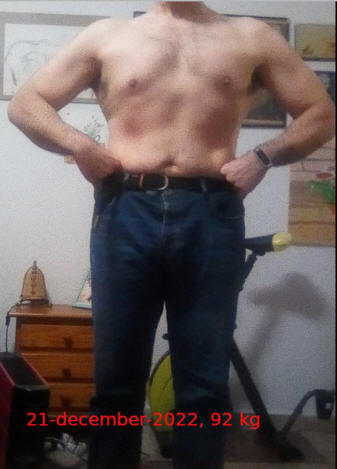
Marco, A mnemonist (master of memory) today: Slimmer, thinking and training his way to lifelong fitness and health.
January 1, 2023
Comment on this article: FEEDBACK
The Keating Clan: Academic Degrees & Physical Excellence
In the last seven months, through a random set of coincidences, I have ended up authoring four different "Success Stories" for Clarence's website, three of them about people I know and one about myself. In the course of my correspondence with Clarence regarding these different stories, I mentioned offhandedly a bit of background about my three brothers, all of whom are still training in one way or another.
In response to that information about my siblings, Clarence emailed me the following message and invitation:
"Loved your summary for fitness levels of your brothers. That would be a wonderful story in itself, with photos of everyone, of course. The Keating Clan beats anything I've ever heard--for brains and brawn. Seriously, our readers would love hearing what all of you do for a living—and for fitness."
Clarence is being too kind to suggest that nobody can match the Keating boys for "brains and brawn," but I do think that my brothers and I make for an interesting quartet. The four of us certainly have a lot in common, but there is also a lot that is unique to each of us. Let me start with the overlapping trends among the four Keating brothers, two of whom have already reached age 60, and the other two are not far behind. First, three of the four of us ended up in the education field just like our parents, both of whom spent their careers with the Chicago Public School system. Second, all of us have continued to train as we have aged, albeit with different modalities of training. Third, all of us have struggled with (and largely overcome) various sports-related or training-related injuries, which I suspect is pretty typical with any aging athlete. Finally, all of us have been through a lot of schooling. As my brother Mike's friend once observed, "Those Keatings have more degrees than a thermometer!"
Any story about the Keating brothers has to begin with a description of our parents, Tom and Joanne. Our dad (who died last summer at age 86) was clearly our inspiration in the sports/fitness area, and our mom led the way in the schooling category. Our Dad was a late bloomer and an overachiever for most of his life. Growing up as the fourth of five boys on the Southeast Side of Chicago, he always preferred sports to books. He made it through high school but failed in his first attempt at college because he spent more time with the basketball team than he did at the library. But on his second try, he got his education degree from Chicago Teacher’s College and began what would be a 42-year career with the Chicago Public School system, the last half as a school principal.
Despite our Dad’s rocky academic path, all four of us boys ended up liking school a lot more than he did, and he encouraged us through high school, college, and even graduate school. For his own part, our Dad ended up getting his master’s degree in Geography while working full-time and helping raise the four of us. Despite our Dad’s full-time job, his summer jobs and his Master’s program, he was a very involved and fun Dad, and he was generous to a fault. He didn’t like to discipline us, but fortunately none of us really needed much of that. He did, however, love to play with us and even with our friends. Our Mom used to joke that she was really raising five boys, not four.
Our Dad was a multi-sport athlete, and he instilled in all four of us boys a love for sports. As a young man, our Dad’s “go-to” sports were basketball and softball. As he grew older, his main sport became tennis, and he was able to play that until into his early 80's. Our Cousin Catherine used to ask our Dad when he was in his 70's, “Uncle Tom, what is your plan when you aren’t able to play sports anymore?” To which he would candidly reply, “There is no Plan B.”
When tennis was no longer an option, our Dad continued to play golf, which as a younger man he would argue should not even qualify as a sport. Eventually, even golf was not possible, so he tried to make himself enjoy reading more, definitely not his strong suite. For him, finishing an entire book was such a momentous feat that he would ceremoniously fling the book across the room to mark the occasion. Luckily, he preferred paperbacks.
Our Mom, by contrast, was never much into sports but she loved (and still loves) her books. She had to put aside her college plans after getting married at age 21 and having four boys over the space of six years. Once her boys were all in school, however, she went on to earn both a bachelor's degree in education and a master's degree in special education. Now that she is 84, our mom is part of a monthly book club, and she also continues to pursue her lifelong passion for painting. Several years ago, she joined a local water aerobics class, and recently began hour-long sessions with a personal trainer to improve her strength and balance.
With that uplifting background, I’ll run through my brothers and I, from oldest to youngest, giving a brief capsule of our "schooling" and "training."
Kevin, 62
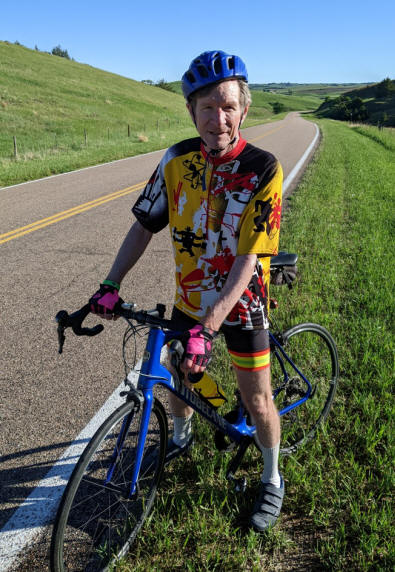
Schooling: Kevin is the math whiz of the family. He was also captain of our high school chess team at St. Laurence High School in Burbank, IL. He got a full scholarship to Washington University in St. Louis (where I now teach at the law school) and helped his Washington U team win the Putnam national math championship during both his junior and senior years. After graduating with a degree in math, Kevin went on to earn his PhD in math at Harvard.
He’s now a tenured member of the University of Florida math faculty, where he coaches the school's Putnam math team.
Training: As a child, Kevin was an unorthodox but effective athlete. He played high school tennis for two years and won the sophomore singles title for the Chicago Catholic League. Kevin also played on the softball team that we formed with our neighborhood friends when we were in our teens, and competed successfully in local adult leagues. When Kevin went to graduate school, he got into squash and Ultimate Frisbee along with his lifelong passion of bike riding.
When he was 35, Kevin partially tore the ACL in his right knee and had surgery. As he approached 50, he reinjured that same knee and had to give up on the squash and Frisbee, because both required making lots of hard cuts and stops.
He is still able to ride his bike 100 to 150 miles each week—and recently did the annual Tour de Nebraska across the state of Nebraska, covering 370 miles in six days and camping along the way.
Dan (me), 60
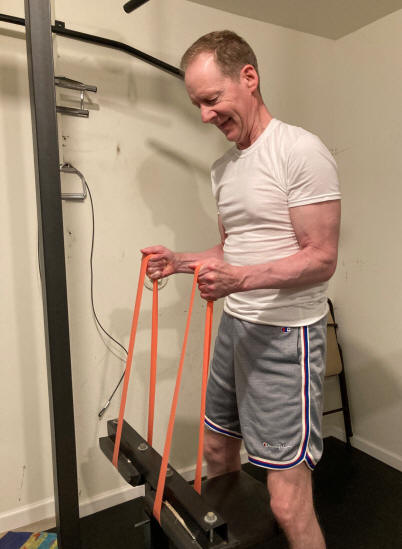
Schooling: Writing has always been my passion. For six summers from age 16 to 21, I was a full-time sportswriter for the Daily Southtown Economist in Chicago. For a time, I thought that sports writing would be my life's work, but I ended up switching gears and going to law school.
After graduating with an English and Psychology major from Monmouth College, I got my law degree at the University of Chicago Law School. I practiced bankruptcy law for two years as an in-house lawyer for the First National Bank of Chicago before joining the Washington University law faculty in the fall of 1988.
Training: Growing up, my favorite sports were baseball, basketball, tennis and ping-pong.
Because I was never big, tennis was the sport where I could compete most effectively. I was able to play tennis at both the high school and Division III college level.
I have been training since age 15, although my training has evolved over the years. In my earlier Success Story, Thriving in the Basement, I detailed how I have had to adapt my training to account for both injuries and aging.
I began reading Clarence's books and columns in 1980, when I was freshman at Monmouth College. His training wisdom has long guided all of my training decisions and strategies.
Mike, 58
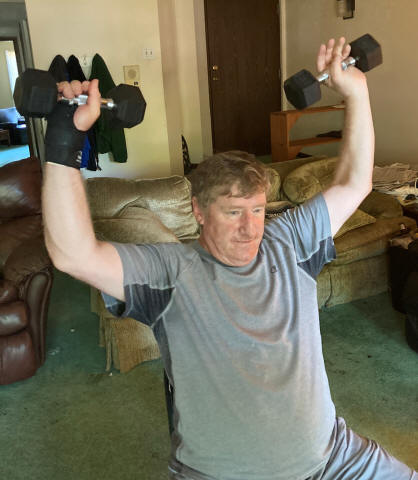
Schooling: Mike's best topics in school were always math and business. He got his degree in Finance from the University of Illinois and followed that up with an MBA degree, also from Illinois.
He never pursued his business interests and instead became the star math tutor at Moraine Valley Community College in Palos Heights, where he has worked for the past 22 years.
Training: Mike has always been the best natural athlete of the four Keating boys, and the only one of us who is a true mesomorph.
The other three of us definitely tend towards an ectomorph frame, whereas Mike's limbs have always been thick and muscular.
My brother Tom remembers a photo of Mike when he was about 6 or 7 in his swimsuit. He was already displaying an impressive six-pack!
He played basketball in grade school and in his freshman year of high school, where was a strong varsity track athlete. During his senior year, he placed fourth in the high jump in the Chicago Catholic League.
He has continued to play organized sports longer than the rest of us.
He played in a basketball league into his late 30's, and on a softball team into his 50's, when he tore his upper leg.
Mike still bowls and golfs on a regular basis, and also trains.
Due to the pandemic, he has shifted his training from the gym to his condo living room, where he has weights and a treadmill.
His training has also been hindered by severe carpal tunnel syndrome, for which he has had surgery. As a result, his doctors have advised him not to grip anything too tightly.
As a result, he has modified his strength training by using lighter weights, higher reps, and resistance bands.
Tom, 56
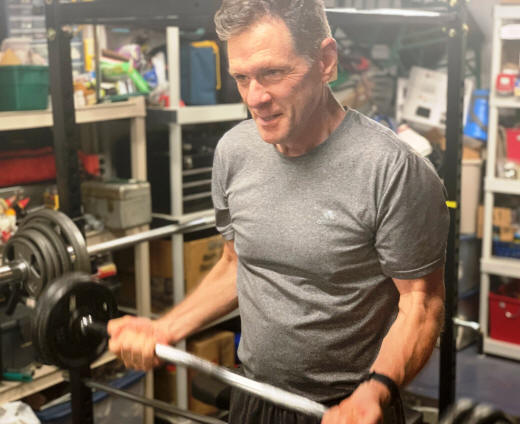
Schooling: Tom is our "jack of all trades" when it comes to schooling.
He began his college career at the School of Engineering at the University of Illinois as a computer science major, but then fell in love with biology his senior year and wanted to switch majors.
Mom told him not to switch majors, but instead to consider graduate school in biology. So, he got his computer science degree from Illinois and then went on to get his Ph.D. in biology from Purdue.
After getting his Ph.D., he and his wife Heather (who also got a Ph.D. in biology from Purdue) did ten years of post-doctoral research, most of it at the University of Wisconsin.
When he was 35, I persuaded him to switch fields and go to law school at Washington University. So, with a wife and two young sons in tow, Tom moved to St. Louis and got his law degree, adding a third son to the mix (along with a third degree!) during his third year of law school.
Today Tom is back in Madison, WI, working for Quarles & Brady as a patent lawyer specializing in prosecuting biotech patents for clients in the health-care field.
Training: As a child, Tom was a late bloomer when it came to sports. He did finally come along, though, and was a solid track athlete at St. Laurence High School.
He has always had a knack for running, and to this day he has an incredible aerobic capacity.
He became an avid bike rider, but when he started working from home in 2015, he replaced his daily bike rides to and from work with about 30 minutes of running each day.
After about a year or so, the running took its toll on his back. He had to find a more back-friendly replacement for running.
At that point, he purchased a Schwinn Airdyne for his basement and began each morning with a 30-minute intense ride at level 5.0, keeping his heart rate in the 145-150 range.
(Try keeping your heart rate in that range for that long and you will appreciate Tom's uncanny aerobic capacity!)
He soon realized that he was overtraining at that daily level of exertion, so he now alternates the Airdyne with slightly lower-intensity workouts on either his rowing machine or his treadmill.
A few years ago, he added strength training to the mix when his oldest son Colin set up a power cage in their basement.
* * *
I’ll close this story about the Keating brothers with a brief description of a family tradition that captures our shared sense of competition and camaraderie.
When the four of us were in our late teens and early 20's, our dad was the principal at Mark Twain elementary school in Chicago. On many Saturday mornings for a number of years, the four of us would meet along with our dad (who played basketball into his 60's) and a few friends of ours for four-on-four basketball battles in the Mark Twain gymnasium.
It wasn't enough for us that we played these games -- we also needed to videotape them! So we would hire the AV guy at our dad's school to come and tape these 90-minute affairs.
Immediately following the morning games, we would come back to our house, watch the videotapes and do detailed statistics for every player on the floor. We still have dozens of the VHS tapes of those games, each one stuffed with a "stat sheet" that chronicles who did what on that particular morning.

I share this last anecdote because I think it captures the spirit of the Keating brothers (and dad) in our formative years: we loved sports, competing, and challenging ourselves.
And most of all, we loved each other's company!
At the same time, we also believed in individual accountability, measuring our own performance each game and vowing to do better the next time.
All of those habits and characteristics have also proven to be invaluable in the academic and work settings, helping each of us to forge our own paths in life outside of the sports arena.
* * *
It's only
fitting that we close with a photo of Joanne & Tom Keating, the Mom and Dad who
raised the Amazing Keating Clan.
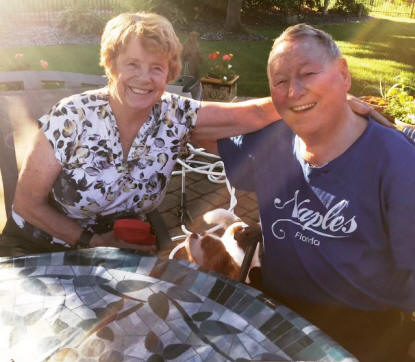
Dan Keating, Professor of Law
August 1, 2022
Comment on this article: FEEDBACK
Mental & Physical Success at 87
In my 69th year of continuous weight-training, I'm reviewing my notion of physical and mental “SUCCESS.”
Physically, I lift weights every other day. In between I powerwalk up steep slopes. My mental well-being can be evaluated by the publication of my last book four years ago and my ongoing manuscript for another book. I’ve written a great deal on education (from neurology to economics), but I’m currently enjoying a totally different subject. I'm about 110 manuscript page into employing Shakespeare to understand contemporary life. Reading Shakespeare has long been part of my personal reading and last year, trying to survive Covid confinement, I felt inspired to add my two cents to the volumes on Shakespeare, despite recognizing that the last thing this world needs is another book on The Bard!
For this project, I give a tip of the hat to my relentless weight lifting, aware of the research documenting its benefits for brain health.
My lifting began on my 18th birthday, when I asked my parents for a York Big 12 weightlifting set. I was a chubby, near high-school dropout who failed several courses and got drunk on most weekends. All that changed when I began applying what I learned from weightlifting to the rest of my life: consistency, discipline, planning, positive accomplishment. As I brought these and similar dimensions of lifting to my health, education and life purposes, I was able to overcome the deficiencies and damages of my youth. I managed to get a “provisional” college acceptance and went on to obtain a Ph.D. and, again, write several books.
After obtaining some muscle and strength with my York Big 12 set, I advanced to competitive Olympic lifting, and then powerlifting. In the 165 lb. class, I achieved some decent poundages—a 235 overhead press, 200 snatch, 315 clean & jerk, 300 bench press, 500 squat and 555 deadlift. After age 40, I began competing in senior powerlifting, continuing, into my late-60s, to put up decent (although, of course, slowing diminishing) numbers. Week after week I lifted, loving every workout in my basement gym, psyching up for heavy 3 or 5 rep sets, putting number after number in my workout notebooks, rarely missing a workout.
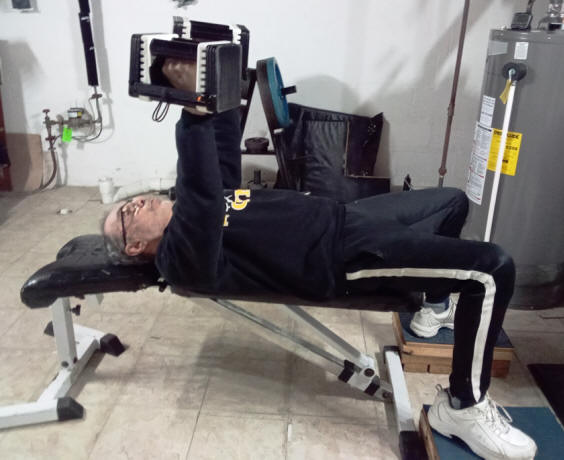
Photo courtesy of Gerald Coles
Then everything went awry! At age 71, after feeling increasing chest discomfort when out walking, an angiogram revealed I had two blocked arteries, for which stents were recommended.
How could this have happened me! My diet was pretty healthy, although I did eat animal foods and, occasionally, unhealthy food, such as a cheese pizza. My aerobic capacity was very good, judging by my hikes through hills and mountains. However, I did recognize that my everyday stress level was consistently high: frequently I was deep into research on complex topics and commonly writing to meet a publishing deadline. Additionally, my lifting workouts over the decades were filled with intense “psyching up” to make heavy lifting goals. Emotional intensity was a constant in my workouts!
In the hospital, queued up for two stents, I convinced the doctor to implant just one, in the almost completely blocked artery, and allow me to employ a dietary change to open the other. The change I undertook was grounded in research by Drs. Dean Ornish and Caldwell Esselstyn, which used plant-based, very low fat, diets to reverse heart disease. I use the term “plant-based,” rather than “vegan,” because the latter simply connotes avoiding animal food. Consequently, a person can be a “vegan” and eat all the high-fat, faux-food garbage common in the American diet. Of course “plant-based” doesn’t necessarily guarantee a healthy diet, but following the nutritional guidelines of Ornish and Esselstyn—as I have for the past sixteen years—it’s entirely that! Without a statin, my total cholesterol dropped to 145, my LDLs to 87. Four years ago, after a bike accident, the physicians, knowing my stent history, employed an angiogram to determine if artery blockage had contributed to the cause of the accident. Instead, they found that the two previously blocked arteries were 100% clear!
To reduce excessive workout stress, I abandoned powerlifting goals, changing to bodybuilding training, with an emphasis on muscle size and just “more than enough” overall strength. For the latter goal, my central exercise is the trap bar deadlift, loaded to 225 lbs for a total of 20-to-25 reps, three-to-six-reps-per-set. I could use more weight but 225 lbs. achieves my body strength goal without having to amp up emotionally. (I look chunky in this trap bar photo, but it's the contemporary oversized sweatshirt; my waist remains 32"!)
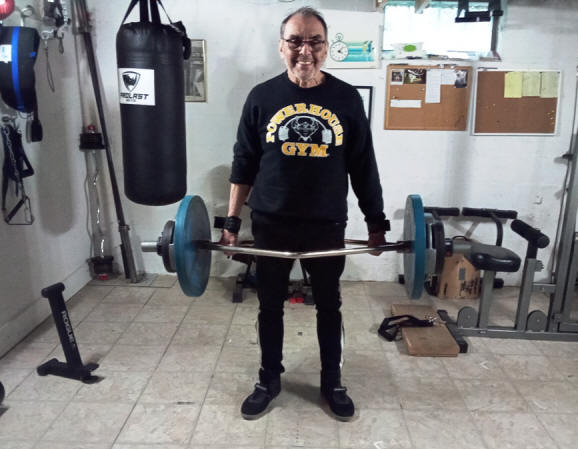
Photo courtesy of Gerald Coles
For most exercises I keep the reps in the 15 range, doing a couple of drop sets for a total of three work sets. The “three sets most of the time” feels right because I lift in a home gym, without a large array of equipment, and feel my targeted muscles are “well worked” after the third set. Were I lifting in a commercial gym, with more equipment for more exercises, I’d probably reduce my sets for each movement to two, so that I don’t overtrain. However, few principles are written in stone! For example, when doing one-arm movements, such as dumbbell rows, I’ll do just two sets because a one-armed movement is almost a full-body one, so that my “two sets” actually feel more like four sets when completed.
Each workout is a full-body routine. (In my previous powerlifting routines, I focused on one of the powerlifts, with the addition of a small number of bodybuilding lifts.)
I employ four different workouts over eight days. “Four” has nothing to do with any bodybuilding wisdom or design. Rather, it’s derived solely from the array of favorite exercises that require four workouts to fit them into my training program. Each workout is about 1hr. & 15min.
On the days between my lifting workouts, I walk for over an hour in a nearby park, where there are a dozen slopes to work into my routine. Lately, to deal with the lingering impact of Covid-stress, I vary the walking intensity between power-walking and meditative walking.
My walking routine is year-round: In the winter snow I’m out trekking with snowshoes or Kahtoola micro spikes.
A closing observation about the term “success.” The word has various meanings, from “triumph” to “accomplishment.” For me, its chief meaning is “positive continuance.”
Thanks in great degree to weightlifting, I’ve been able to continue the enrichments of my life—a wonderful marriage, good health, everyday physical fitness, a creative mind.
“Success,” like life, ultimately is transitory, but while it’s around, it’s wonderful!
Gerald Coles
Rochester, NY
August 1,
2022
Comment on this article: FEEDBACK
Runner Finds Miracle Cure in Strength Training
After my Success Story, “Thriving in the Basement,” was published on the Ripped website, I sent the link to a few friends that I knew were into health and fitness. One of those friends, Bill Barrett, is a 64-year-old bankruptcy lawyer in Chicago. I knew that Bill was a lifelong runner and liked to play in recreational volleyball leagues. What I did not know was that he had struggled with a painful knee injury that had stumped several medical doctors.
That injury was ultimately and somewhat miraculously cured through the intervention of Bill’s personal trainer and the magic of strength training.
Here is what Bill wrote in response to my Success Story:
“I have a story of my own that I like to share with late middle-age people suffering from body aches and stiffness. From the age of 14, I have been a runner. Thirteen marathons, 20 half marathons, and too many shorter runs to count. As I entered my 40s, I began to experience joint and soft tissue pains. Not everywhere at once, but over the next 20 years just about everything (knees, feet, hip, back, hamstrings, shoulders, upper arms) hurt at one time or another. I assumed that it was part of getting old. Rest and ibuprofen would provide relief until the next onslaught.
“About four years ago I began experiencing pain in my right knee. The pain was only felt at night and seemed unrelated to whether I had run during the day. The pain was not severe, but it would wake me after about three hours of sleep and would then re-awaken me throughout the night.
My primary care doctor jumped to the conclusion that it was typical arthritis and that the cure was ibuprofen. When that provided no benefit, I went to an orthopedic specialist who, after an MRI, confirmed the diagnosis of arthritis and added a diagnosis of a bone bruise at the top of the femur. I was given a more powerful NSAID and a prescription for physical therapy. Neither provided any relief. I then went to see the head ortho doc at Northwestern who, upon reviewing the MRI results, concluded that my knee joint was fine and that whatever was causing the pain was not bone or soft-tissue related. He suggested that I might see a neurologist.
“Frustrated, I then applied my 35 years of research experience to the Google machine and found a condition, often misdiagnosed as arthritis, which was nothing more than a trapped nerve. The symptoms -- pain that is only felt at night and non-responsive to NSAIDS -- matched mine. I found a sports neurologist who, without my prompting, reached the same conclusion. The neuro doc gave me a nerve block shot (Cortisone and Novocain) that, if it worked, would confirm the trapped nerve diagnosis. The shot provided complete relief that lasted for six months.
“As the shot wore off and the pain returned, I had to decide whether to (i) get another shot, which was not a long-term solution, or (ii) have surgery, where the nerve would be yanked free. At this time, I got a new trainer. I gave him the whole story. He said that while he was not a doctor or physical therapist, he could see that, from a strength standpoint, I was underdeveloped for all that I was trying to do (run 20 miles a week and play volleyball twice a week). In his view, the lack of adequate strength was causing various overuse injuries across the body. I decided to defer doing anything about the trapped nerve.
“So we began a program of intensive strength training. I had had trainers before, but no one pushed me to the limit like this trainer did. Eschewing machines, we focused on squats, lunges, deadlifts, shoulder presses, and all sorts of core exercises. Nothing got better overnight, but after three months the knee pain began to subside. After six months it was gone. But it's better than that. No more plantar fasciitis, lower back pain or stiffness, or shoulder pain. No more NSAIDS of any sort, no more icing. I could dive for volleyballs and pop back up without the slightest twinge.
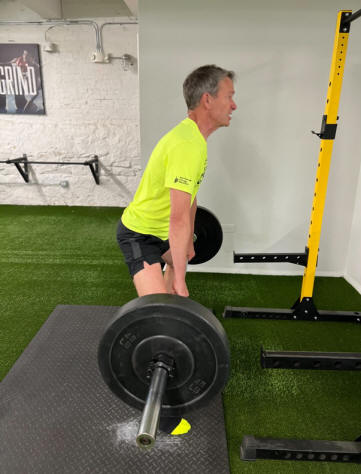
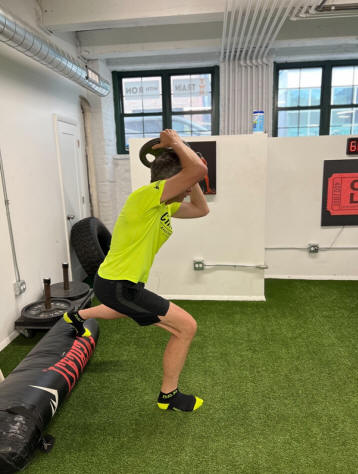
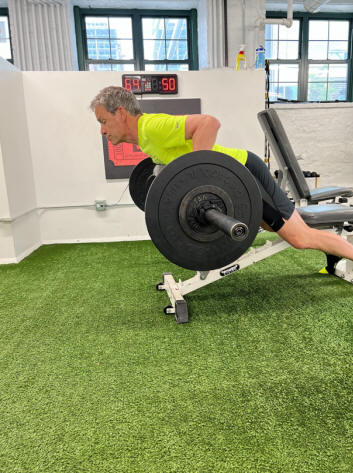
These photos provided by Bill (and Dan) illustrate the type of multi-joint exercises recommended by his new trainer, Steve Ferrah, to condition his body to tolerate and thrive in the course of his hyper-active lifestyle.
You'll notice that Bill's lower back remains flat during the course of these movements.
“As for the nerve entrapment, it was caused by the sartorius muscle trapping the infrapatellar branch of the saphenous nerve. In other words, the sartorius muscle, which connects the inner knee joint with the outer hip, was tightening up at night because it was overused and under-strengthened. As the training strengthened the muscle, the nocturnal tightening of the muscle relaxed, and the pain went away. “
* * *
Following up on this message, I arranged a Zoom call with both Bill and his 31-year-old trainer, Steve Ferrah, to learn more about the details of Bill’s miracle cure. I learned that Bill began his running career as a member of his high school cross-country team. After high school, he drifted away from running but then came back to it around age 30 when he realized how good he felt when he was in shape enough to feel the “runner’s high” when he was three or four miles into a run.
Bill first got a personal trainer when he was in his 40's, but that trainer’s approach to strength training was not as thorough and systematic as his current trainer Steve’s methods. Two factors distinguish Bill’s current strength training from his earlier attempts. First, Steve increased the weights and repetitions of Bill’s exercises so that Bill is now being pushed much harder than he was before. Second, Steve insists on a balanced approach where complementary muscles must be worked equally. If Bill does leg curls for his hamstrings, then he needs to do leg extensions for his quadriceps. If Bill does biceps curls, then he needs to work equally hard on triceps.
Bill lucked into Steve after his previous trainer at Equinox Health Club in Chicago left the club. Steve is known at the club as the “go to” guy for clients who are struggling to recover from an injury. He says that one insight he has picked up during his nine years in the business is that the point of pain is not necessarily the source of pain. So, for example, just because Bill’s knee was bothering him did not mean that the injury was due to the knee. In Bill’s case, the knee issue was largely due to lack of flexibility in his ankles and hips. He’s very careful with clients like Bill to go slowly and not risk aggravating the injury. One key to managing his client’s injuries is to get constant feedback as they try each new exercise, giving him a sense of whether the exercise is aggravating the problem or helping it.
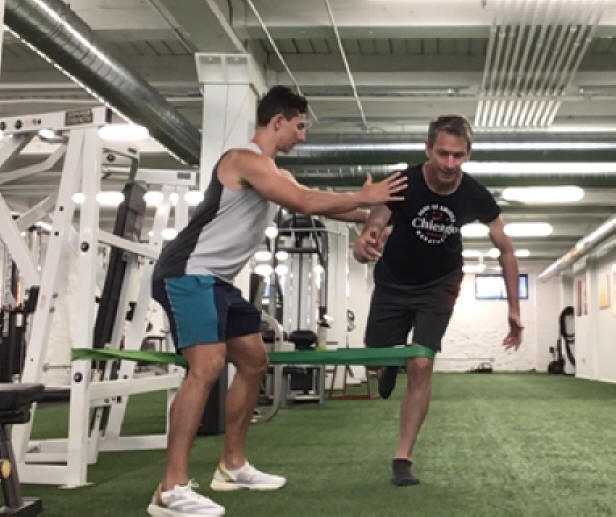
This photo shows Steve spotting Bill as the resistance band places sideways stress on his hip, knee and ankle, stabilizing his entire leg.
Steve's muscular hips and thighs show that he practices what he preaches.
Steve was inspired to become a personal trainer through his own journey as an athlete in high school and college. He did not have all of the natural physical gifts that many great athletes have, but made up for it with grit and determination. He struggled with lower back injuries during high school and wishes now that he had someone like himself in high school to help him work through those struggles in a more productive and efficient way.
He has spent hundreds of hours outside of work attending workshops and learning on his own about the physiology of training. This fall he will be starting a doctoral program in physical therapy at the University of Illinois at Chicago. He plans to still keep working with some of his clients, including Bill.
* * *
As Bill looks back on more than three decades as a runner, he wishes that he knew as a 30-year-old what he knows now about the critical role of resistance training in making a runner stronger and less prone to injury.
“I really developed as a runner in the 1990s and early 2000s,” he says. “At that time, practically all of the emphasis was on what you ate and on stretching and massage. There was very little emphasis on strength.
“Had I known then what I know now, I could’ve been running all of those years without lower back or shoulder pain.
“And now, with Steve’s help, all of this improvement is happening so suddenly. I am actually kind of astonished that the general public and the running community still do not seem to understand and promote the importance of strength training.
Imagine what type of runner I might have been if I had known this 30 years ago, and all of the injuries that I might have avoided.
“A least I can get that benefit going forward, and I am very grateful to Steve for that.”
Bill Barrett, Esq. and Dan Keating, Esq.
July 1, 2022
Ripped Enterprises, P.O. Box 51236, Albuquerque, New Mexico 87181-1236
or
street address: 528 Chama, N.E., Albuquerque, New Mexico 87108,
Phone (505)
266-5858 , e-mail: cncbass@aol.com ,
Office hours: Monday-Friday, 8-5, Mountain time
Home | Products Index | Ripped Bks | Lean Adv. Bks | Lean For Life | Recommended Bks | |Consultations | Tapes | To Order | Feedback]
Copyright © 2022 Clarence and Carol Bass. All rights reserved.